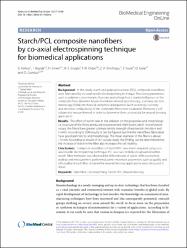| dc.contributor.author | Kömür, Baran Heval | |
| dc.contributor.author | Bayrak, Ferda | |
| dc.contributor.author | Ekren, Nazmi | |
| dc.contributor.author | Eroğlu, Mehmet Sayıp | |
| dc.contributor.author | Oktar, Faik Nüzhet | |
| dc.contributor.author | Aydın Sinirlioğlu, Zeynep | |
| dc.contributor.author | Yücel, Sevil | |
| dc.contributor.author | Güler, Olcay | |
| dc.contributor.author | Gündüz, Oğuzhan | |
| dc.date.accessioned | 10.07.201910:49:13 | |
| dc.date.accessioned | 2019-07-10T19:37:41Z | |
| dc.date.available | 10.07.201910:49:14 | |
| dc.date.available | 2019-07-10T19:37:41Z | |
| dc.date.issued | 2017 | en_US |
| dc.identifier.citation | Kömür, B. H., Bayrak, F., Ekren, N., Eroğlu, M. S., Oktar, F. N., Aydın Sinirlioğlu, Z. ... Gündüz, O. (2017). Starch/PCL composite nanofibers by co-axial electrospinning technique for biomedical applications. BioMedical Engineering Online, 16. https://dx.doi.org/10.1186/s12938-017-0334-y | en_US |
| dc.identifier.issn | 1475-925X | |
| dc.identifier.uri | https://hdl.handle.net/20.500.12511/1453 | |
| dc.identifier.uri | https://dx.doi.org/10.1186/s12938-017-0334-y | |
| dc.description.abstract | Background: In this study, starch and polycaprolactone (PCL), composite nanofibers were fabricated by co-axial needle electrospinning technique. Processing parameters such as polymer concentration, flow rate and voltage had a marked influence on the composite fiber diameter. Fourier transform infrared spectroscopy, scanning electron microscopy (SEM), mechanical and physical properties (such as density, viscosity and electrical conductivity) of the composite fibres were evaluated. Moreover, a cell culture test was performed in order to determine their cytotoxicity for wound dressing application. Results: The effect of starch ratio in the solution on the properties and morphological structure of the fibers produced was presented. With lower starch concentration values, the fibers have greater ultimate tensile strength characteristic (mostly 4 and 5 wt%). According to SEM results, it can be figured out that the nanofibers fabricated have good spinnability and morphology. The mean diameter of the fibers is about 150nm. According to results of cell culture study, the finding can be determined that the increase of starch in the fiber also increases the cell viability. Conclusions: Composite nanofibers of starch/PCL have been prepared using a co-axial needle electrospinning technique. PCL was successfully encapsulated within starch. Fiber formation was observed for different ratio of starch. With several test, analysis and measurement performed, some important parameters such as quality and effectuality of each fiber obtained for wound dressing applications were discussed in detail. | en_US |
| dc.language.iso | eng | en_US |
| dc.publisher | BioMed Central Ltd. | en_US |
| dc.rights | info:eu-repo/semantics/openAccess | en_US |
| dc.rights | CC0 1.0 Universal (CC0 1.0) Public Domain Dedication | * |
| dc.rights.uri | https://creativecommons.org/publicdomain/zero/1.0/ | * |
| dc.subject | Nanofiber | en_US |
| dc.subject | Electrospinning | en_US |
| dc.subject | Starch | en_US |
| dc.subject | PCL | en_US |
| dc.subject | Wound Dressing | en_US |
| dc.title | Starch/PCL composite nanofibers by co-axial electrospinning technique for biomedical applications | en_US |
| dc.type | article | en_US |
| dc.relation.ispartof | BioMedical Engineering Online | en_US |
| dc.department | İstanbul Medipol Üniversitesi, Tıp Fakültesi, Cerrahi Tıp Bilimleri Bölümü, Ortopedi ve Travmatoloji Ana Bilim Dalı | en_US |
| dc.authorid | 0000-0002-0022-0439 | en_US |
| dc.identifier.volume | 16 | en_US |
| dc.relation.publicationcategory | Makale - Uluslararası Hakemli Dergi - Kurum Öğretim Elemanı | en_US |
| dc.identifier.doi | 10.1186/s12938-017-0334-y | en_US |
| dc.identifier.wosquality | Q3 | en_US |
| dc.identifier.scopusquality | Q2 | en_US |



















